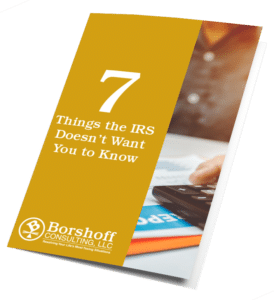Do you owe the IRS money instead of the other way around? You may be caught off guard if you receive an unexpected tax bill.
The first thing you should do is double-check your tax return. Is it right? Why is this debt unexpected? Dig a little deeper; find out what you did differently this year so you can avoid doing it again.
Regardless of whether or not you owe the IRS or they owe you, you need to file your tax return on time and pay as much of the balance as you can now to avoid penalties, fees, and interest.
If you still owe the IRS money after following those steps but cannot afford to pay any more, contact the IRS as soon as you can. Let them know what’s going on and ask for leniency. The IRS offers many payment assistance programs for qualified taxpayers, so they want to help.
They have the following payment assistance programs: the IRS Installment Agreement, the Offer in Compromise Agreement, and the IRS Abatement program. Each program does different things for taxpayers.
They may also be able to put you in the CNC (Currently Not Collectible) status which can save you the headaches of collection calls and letters. This is a temporary solution only.
Finally, look into alternative ways to get money to pay the IRS so you can avoid going into collection status. You may also want to investigate why you have received an unexpected tax debt so that it doesn’t happen next year.
Verify You Filed Your Tax Return Correctly
The first thing you should do, when you see you owe the IRS but were expecting a refund is double-check your tax return. Make sure you properly filed your tax return. Review it closely and carefully.
Were there more business expenses that you had but forgot to put it on your Schedule C? Did you forget to count your home office as a deduction? Why exactly are you showing you owe the IRS money when you thought otherwise?
Are your calculations correct? Most software programs take care of this for you, but it’s a good idea to triple-check your numbers and see if you filled the forms out correctly.
Look over every line of your tax return to ensure that you did everything right; better yet, work with a tax specialist to make sure you entered everything the way you should on your tax return.
They understand taxes better than you do, and they will be able to show you what went wrong on your tax return this year.
File Your Tax Return on Time or File an Extension
The majority of tax returns are due on April 15, 2020 for the tax year 2019. Simple 1040 tax returns and payments should be submitted on or before that day.
Payments are also due on April 15, 2020 for the tax year 2019. The 2020 deadlines for the tax year 2019 can be found on this page.
If you need more time to file your tax return, you can apply for an extension. The due date for the simple 1040 tax returns that have extended is October 15, 2020 for the 2019 tax year.
Payment is still due on April 15, 2020. If you are unsure of how much you need to pay, you should pay the entire balance of what you think you owe. If you underpay, you will owe penalties and interest. If you overpay, you will receive a refund.
To file an extension, you will need to submit IRS Form 4868: Application for Automatic Extension of Time to File U.S. Individual Income Tax Return. That is the correct application for an extension on your taxes for the 2019 tax year.
The IRS assesses penalties in two ways: one is for filing late (so, file on time!) and the other is for failing to pay; so, pay what you can as soon as you can! Know your deadlines, and try to meet them to avoid these penalties.
Pay What You Can As Soon As You Can
When you know that you owe the IRS, you should make a tax payment as soon as possible. This way you will avoid penalties, interest, and fees. If you cannot make a full payment and have exhausted all options, contact the IRS to let them know that you can only pay part of the taxes you owe.
There are many ways that you can pay the IRS, so there really is no excuse for not paying if you have the money. The faster you pay, the fewer penalties, fees, and interest you will owe, so try to pay on time using one of these methods:
- Pay online using DirectPay – This is a direct transfer from your checking or savings bank account straight to the IRS website. There is no processing fee. They also will take other payments this way like your quarterly estimated taxes.
- Pay through the EFTPS (Electronic Federal Tax Payment System) – Another way to pay through your bank account is to pay through the EFTPS. You can schedule payments in advance using this payment method.
There is no processing fee for using this system either. It handles the same payments that DirectPay does, but it also handles corporate taxes and payroll taxes.
- Pay Online via Credit Card or Debit Card – This is a convenient way to pay, but they do charge a processing fee.
- Set up an Automatic Withdrawal – If you used accounting software to prepare your taxes, you can set up a direct debit from your checking account. This is a very fast and simple way to pay the IRS. Plus, if you have it set up one year, you don’t have to enter all of the same information again the next year.
- Set up a Direct Wire Transfer from your Bank – Most banks have no problem accommodating wire transfers, but they may charge you for it; it just depends on the bank.
- Mail a Check or Money Order – Write the check to be payable to the “United States Treasury,” and send it with IRS Form 1040-V (a payment voucher). For full instructions along with the correct mailing address, go to the Pay by Check or Money Order page of the IRS website.
- Pay in Person – You can go directly to your IRS local field office to pay in person. It’s a good idea to make an appointment first (online) so you don’t have to wait for hours. To make an appointment or to find the office, go to the Contact Your Local IRS Office page. There are also IRS “retail partners” that you can go to that will accept your payment in person on behalf of the IRS. For a complete listing of these stores, check out the Official Payments website.
- Pay through an agreed-upon Installment Agreement – If you have an installment agreement, you can set up a monthly payment plan with the agreed-upon amount.
The IRS has taxpayer assistance programs for qualified individuals that may be able to help you pay off or forgive the tax debt you have. Whatever route you take be sure to contact the IRS to let them know why your payment does not match the amount due on your tax return. Communication is the key when dealing with tax debt and the IRS.
Communicate with the IRS
Communicating with the IRS about your tax situation is crucial. If they don’t know what’s going on, you will just get penalties, fees, and interest added to the payment amount you owe. Be upfront with them and explain what happened when you went to file your taxes.
If you made a payment late or partial payment, tell them that. If you only made a partial payment or cannot make any payment, asking them for leniency is the best approach. Just be sincere and honest about your financial hardship and see what they can do to help you.
The IRS has assistance programs that help taxpayers by offering them payment extensions, payment plans, tax debt forgiveness, and more. Talking to the IRS is the best way to settle your tax debt.
Regardless of your situation, if you cannot pay on time and in full, you need to call the IRS. The IRS toll-free number is 1-800-829-1040. Once you begin working with a department, you will have a more specific number to call. For more information on what to do if you cannot pay, refer to the IRS’s website page called: “What if I can’t pay my taxes?”
They do want to work with you and provided you are honest with them about your situation, you should not receive a negative consequence. However, they do have the power to take action if you refuse to file or pay.
In extreme cases, the IRS can press forward with collection actions, issue a summons, enforce a tax lien, revoke your passport, sell your property, and more.
We’ve all heard the stories of the famous people who were brought down by the failure to pay taxes. Then, their criminal empire was torn apart and/or they were sent to jail. Don’t let that happen to you.
Just talk to them, work with them, and be polite. It’s a hassle to sit on hold or to wait in line to work with an agent, but you will ultimately be glad you did. They do want to collect taxes, but they will work with you if you let them. The key is to communicate!
Check Out the IRS Assistance Programs
There is hope for taxpayers who are dealing with unexpected tax debt that they are unable to pay. The IRS does try to help taxpayers in any way that they can. Communicating with them is very important though.
The IRS has many assistance programs for taxpayers. Some of the free programs they offer are VITA (Volunteer Income Tax Assistance) and TCE (Tax Counseling for the Elderly).
Other programs can help with payment assistance. For taxes, the IRS has an installment agreement that allows taxpayers to make payments to the IRS on a scheduled basis, the Offer in Compromise agreement offers debt forgiveness, the IRS Penalty Abatement program can remove penalties, and the Currently Not Collectible status can eliminate collection calls and letters. Each program has specific requirements that taxpayers must meet.
The IRS Installment Agreement
Like any business, the government would rather get paid over time than not at all, so they offer a short-term installment plan available. The IRS Installment Agreement works with taxpayers to pay past-due taxes over the course of time rather than all at once. This allows taxpayers to make payments in regular installments.
If you qualify for an installment plan, you must pay off your balance within 72 months. Typically, that means you can take the balance you owe and divide by 72 to get your monthly installment amount, but you must have an arrangement with the IRS first. You can’t just start paying the IRS in payments. You must first do the proper documentation.
To request an installment plan, you need to use IRS Form 9465: Installment Agreement Request. For the installment payments, you can set up direct deposit with your bank to make things faster and easier.
The Offer in Compromise Agreement
The Offer in Compromise Agreement is a type of debt forgiveness offered by the IRS. This agreement allows the taxpayer to pay the IRS less than the full amount due. It’s typically not an option since most people will not qualify for it. It requires an application fee of $186, complete personal financial statements, initial agreed-upon offer payment, and IRS Form 656: Offer in Compromise.
If applicable, you also need to submit: completed and signed Form 433-A (OIC): Collection Information Statement for Wage Earners and Self-Employed Individuals and/or completed and signed Form 433-B (OIC): Collection Information Statement for Businesses.
The application is explained in full in IRS Publication Form 656 Booklet: Offer in Compromise. There is even a handy application checklist. Keep in mind that the process and application is long, and the majority of taxpayers and businesses will not qualify for this IRS relief program. Decisions on who is approved are made on a case-by-case basis.
The IRS Abatement Program
The IRS Abatement Program allows taxpayers to remove some of the penalties and fees they may owe because of their outstanding tax debt. To request an IRS abatement, you will need to complete IRS Form 843: Claim for Refund and Request for Abatement. This will not relieve you of your tax debt, but it can help with any penalties and fees that you may have.
The IRS does allow 120 days for the taxpayer to pay the full amount they owe before they accrue any penalties, fees, and/or interest. If the taxpayer is still unable to pay, it is suggested by the IRS that they should look into qualifying for the IRS Installment Agreement.
The Currently Not Collectible Status
The Currently Not Collectible Status helps taxpayers who cannot afford to pay any of the tax debt they owe. The status is put in place by the IRS. The IRS agrees that you don’t have to make any tax payments until your financial situation improves. It’s a deferment. The nice thing about this status is that it eliminates endless collection phone calls and letters from collectors about the tax debt in question.
Alternative Ways to Pay the IRS
For those who do not qualify or do not want to use the taxpayer payment assistance programs, there are other ways to get money to pay tax debt. While none of the options is ideal, you may have no choice.
Here are some suggestions on how to get the cash you need to pay your tax bills if you have no other choice:
- Ask family or friends for help.
- Request a personal loan from the bank.
- Sell some assets to generate cash.
- Take out a home equity line of credit.
- Use credit cards or savings.
- Seek employee benefits like a 401-K loan.
- Take money out of your IRS or retirement savings (not recommended).
- Ask for a bonus or other incentive from work that would help pay the IRS.
- Cash-out company shares or stocks/bonds you own.
- Cash-out paid vacation, leave, and/or sick days ahead of time.
How to Prevent Unexpected Tax Payments
What went wrong this year? It’s important to understand the reason why you received an unexpected tax bill so you can prevent it from happening again in the future.
You should keep their W-4 form updated with the most current information regarding life events. This means updating the form when a new child enters the family or when a marriage or divorce takes place. There are other times when you may want to change the amount on your W-4 form.
Unsure what to put as your withholding number? Talk to the human resource director or payroll accountant at your company. Want to find out for yourself? Check out the IRS’s Tax Withholding Estimator. This simple tool will ask you a few questions and then supply you with the right number. If you received an unexpected tax bill or amount due this year, check on your W-4 and keep it updated to ensure your employer takes out the correct amount from your paychecks.
Self-employed taxpayers should follow all of the tax rules and make estimated quarterly payments on time. Since this can be confusing, at least in the beginning, it’s advisable to seek the counsel of a tax expert who can help figure out the amount that the estimated quarterly tax payments should be.
The process of reporting business income and expense on Schedule C may seem overwhelming to a new taxpayer, but it may save you money on your taxes. However, it’s important to follow the tax code exactly to prevent an unexpected tax bill. This is an easy area where small business owners and freelancers mess up on their taxes, especially the first time they use the schedule.
Conclusion
The first step when you realize you owe the IRS money is to double-check your tax return. Did you fill it out correctly Sometimes it just takes a second set of eyes to check out what you did on your tax return to see why you owe unexpected taxes. It’s best to seek the counsel of a tax professional. Taxes are their job so they understand the rules. Follow these 7 tips when looking for a tax accountant.
It’s important to file your tax return and pay your taxes on time. The IRS charges you penalties if you don’t do either of these. Ask for an extension if you need to, but pay what you can as soon as possible. Interest, fees, and penalties will add up if you just ignore the situation.
There are many ways to pay the IRS, so if you have the money you should use one of these methods. You can pay many different ways online, through your bank, by mail, or in person at a local IRS office or at a local retailer that is partnering with the IRS to accept payments from taxpayers.
If you realize you can’t pay the full amount on time, the most important thing to do is to notify the IRS; talk to them about your situation and see if you qualify for an IRS tax relief program, and pay as much of the balance as you can.
If you don’t qualify for any of the assistance programs or if they aren’t enough, do some brainstorming to come up with some alternative, creative ways to make payments. Talk to friends, family, and/or your employer to see about getting the cash to pay the government.
Having an unexpected tax bill can be quite frustrating, especially if you don’t know why, so before moving on to the next tax year, figure out what went wrong this year. Did you forget to make estimated tax payments or is your withholding number wrong on your W-2? Whatever the problem may be, correct it before next year so you don’t have a repeat problem.
Still in a bind and don’t know what to do? Contact our office for expert tax assistance. We specialize in tax preparation, financial planning, and more. To see how we can help out with your tax situation, get in touch with us today! Borshoff Consulting can help you with one-on-one audit assistance, support, and representation. You can trust Indiana’s tax expert!





